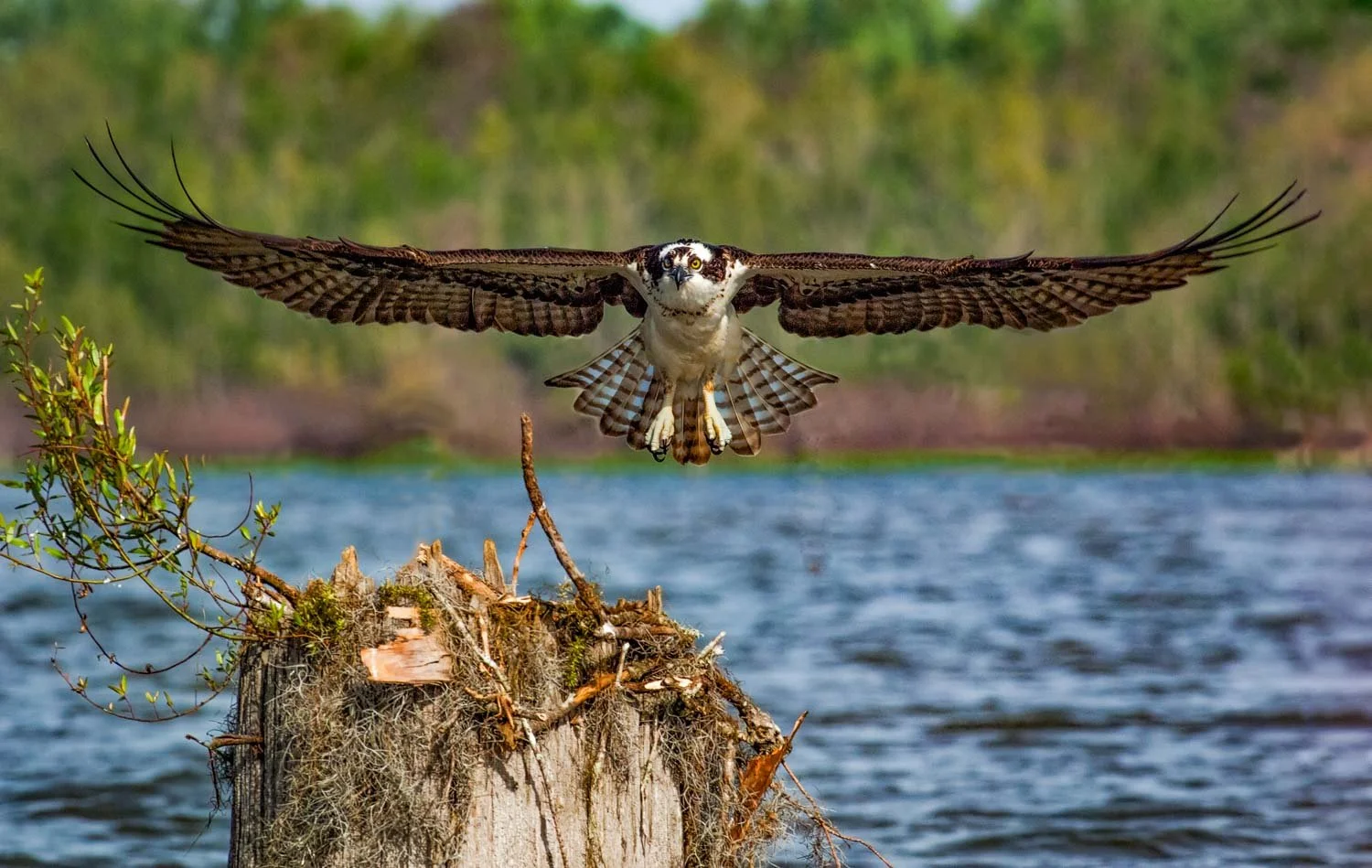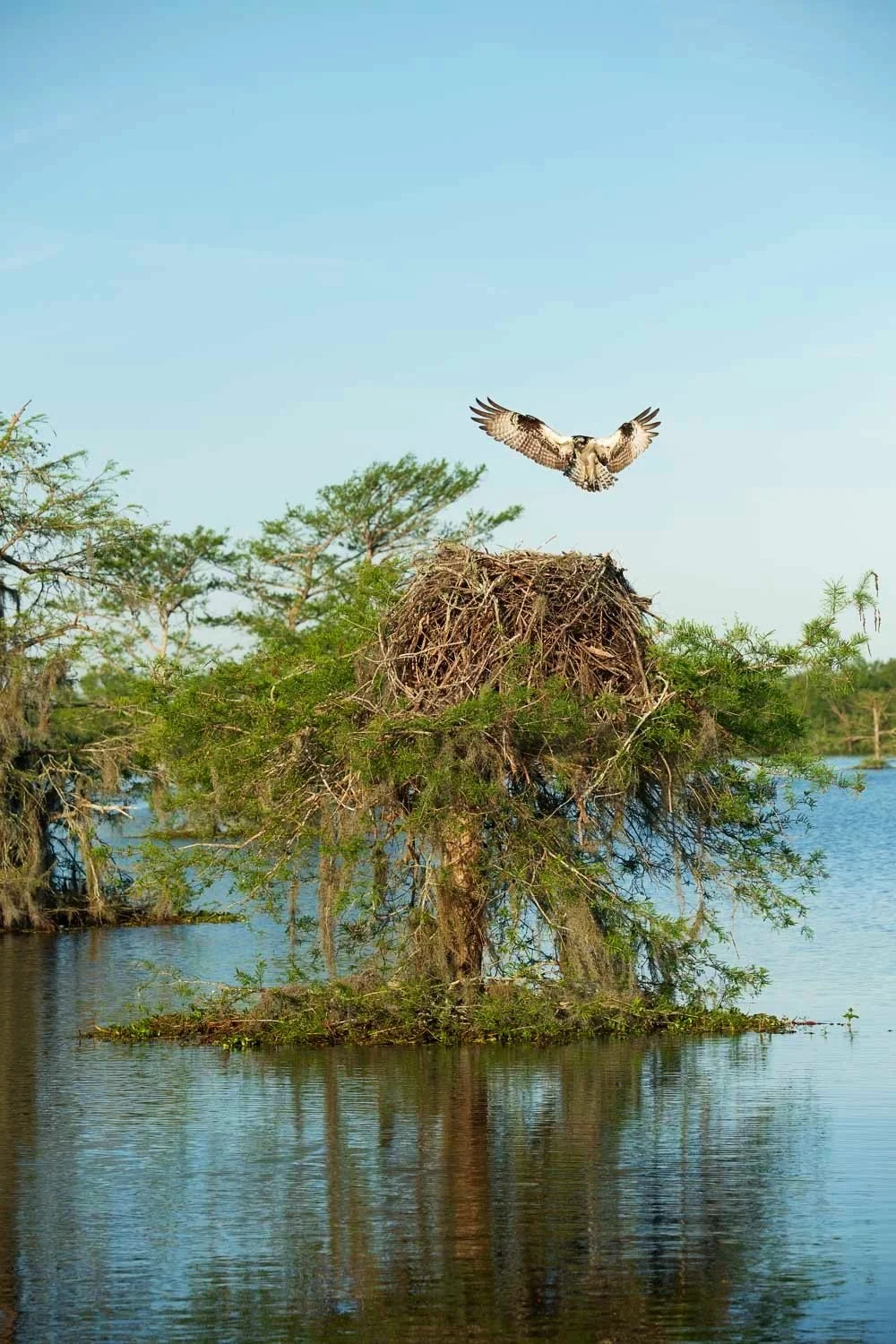Photographing Osprey in the Atchafalaya Basin
An Osprey Landing on it’s Nest in the Atchafalaya Basin–Taken from a Floating Blind
Introduction
I’ve been photographing ospreys in their natural habitat for years, documenting their hunting, nesting, and flight behaviors. Whether on guided bird photography tours or solo excursions, I’ve spent countless hours studying and capturing these majestic raptors. In this post, I’ll cover identification, life cycle, behavior, and techniques for photographing them. If you’re interested in joining one of my Louisiana bird photography tours, you’ll have the opportunity to witness these birds up close.
Identification
Male vs. Female
Size: Females are larger and have a darker chest band, while males are slimmer with a whiter chest.
Behavior: The female typically stays at the nest, while the male provides food.
Male Osprey
Female Osprey
Where & When to See Ospreys
We photograph them in the Atchafalaya Basin on our Photo Tours.
Present year-round in some regions, while migratory populations arrive in spring and leave in fall. I’ve seen Osprey in the area during the winter, so I believe the birds we photograph are here year-round.
Life Cycle
Migration
Some ospreys winter in South America, while others stay in Louisiana year-round.
Nesting
When: Spring through summer.
Where: We find them atop Cypress trees and stumps in the Atchafalaya Basin.
Clutch Size: 2–3 eggs.
Risks:
Predation: Eagles, owls, and raccoons.
Weather: Storms and extreme heat.
Flooding: When the Atchafalaya Basin Floods, the nests are at risk.
Invasive plants: Can alter fish populations, affecting food availability.
Airboats: Disturb nesting sites.
Osprey Returning to its Nest
Mating
When: Begins in early spring.
Duration: Pairs stay together for life but reunite only for the breeding season.
Average lifespan: 10–20 years.
Behavior
Feeding
Prefers clear water for spotting fish. The Atchalaya Basin is ideal.
Diet: 99% fish, typically mullet, catfish, and perch.
Role division: The male hunts and brings food, while the female feeds the chicks.
Vocalization
Alarm Call: Sharp, repetitive “cheep-cheep” when threatened.
Begging Call: Drawn-out, whiny call from chicks or a hungry female.
Contact Call: Soft “peep-peep” between mates.
Courtship Call: High-pitched whistles during aerial displays.
Sources for Calls: Xeno-Canto and Macaulay Library.
Photographing Ospreys
Wind Considerations
Direction: Ospreys take off into the wind—position yourself accordingly.
Speed: Strong winds affect flight dynamics, requiring adjustments in shutter speed.
Lighting Conditions
Front Lighting: Best for sharp details and clear colors.
Back Lighting: Creates dramatic silhouettes but requires exposing for the highlights either using exposure compensation or manually exposing.
From a Boat
It allows close access, but stability is crucial—use fast shutter speeds. I try to keep shutter speeds at or above 1/3200s and use ISO settings up to 12,800.
For the best photographs, position the boat downwind for the best approach and plan your shooting when the wind is from the sun's direction.
Camera Angle
Lower nests are better, as you’re at the bird's eye level, and they enable you to get water or foliage as an out-of-focus background rather than a blue sky.
Camera Settings
Shutter Speed: 1/2000s or faster. I prefer 1/3200s
Aperture: f/5.6 to f/8 for a sharp subject.
Focal Length: 500mm or more for close-ups.
ISO: Adjust based on lighting conditions. With our modern cameras and good noise reduction software, a higher ISO with a sharp photo is better than a blurry photograph at a lower ISO.
Mirrorless Cameras with Bird or Animal focus modes make sharp photographs much more achievable than older DSLR Cameras.
An Osprey Landing on a Low Nest –Wind and Sun at my Back–Ideal Conditions!
Osprey Silhouette–Photographed at Sunrise with the Sun behind the Bird
Using Floating Blinds
Great for low-angle shots near the water surface.
Allows for a stealthy approach to nesting or feeding ospreys.
Summary
This post covered osprey identification, life cycle, behavior, and photography tips. Understanding their habits will improve your experience, whether observing them in the wild or capturing them going to and from their nest.
Resources for Further Study:
If you want to learn more about bird photography tours, please reach out!






